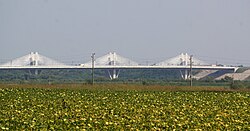Vidin–Calafat Bridge
| New Europe Bridge | |
|---|---|
 |
|
| Coordinates | 44°00′08″N 22°56′54″E / 44.0021554°N 22.9482770°E |
| Carries | Four lanes of roadway, one railway track and a combined bicycle path/pedestrian walkway (the designed second walkway was not completed: it runs only from the Bulgarian river bank to the island under the bridge) |
| Crosses | Danube |
| Locale | Between Calafat, Romania and Vidin, Bulgaria, at river kilometer 796 |
| Official name | New Europe Bridge |
| Website | vidincalafatbridge.bg |
| Characteristics | |
| Design | Cable-stayed bridge |
| Total length | 1,971 m (6,467 ft) |
| Width | 31.35 m (102.9 ft) |
| Longest span | 180 m (590 ft) |
| History | |
| Designer | Fernández Casado |
| Constructed by | FCC Construccion |
| Opened | 14 June 2013 |
| Statistics | |
| Daily traffic | 2,590 vehicles/day |
| Toll | 0–37 euro |
|
|
|
|
|
The New Europe Bridge, previously known as the Danube Bridge 2 (Bulgarian: Дунав мост 2, Dunav most 2), and informally called the Calafat-Vidin Bridge (Bulgarian: Мост Видин–Калафат, Most Vidin–Kalafat; Romanian: Podul Calafat–Vidin), is a road and rail bridge between the cities of Vidin, Bulgaria and Calafat, Romania. It is the second bridge on the shared section of the Danube between the two countries. It is a cable-stayed bridge and was built by the Spanish company Fomento de Construcciones y Contratas, at the cost of €226 million. It was officially opened with a ceremony held on 14 June 2013. The first vehicles were allowed to cross the bridge after midnight, on 15 June 2013.
As early as in 1909 the local authorities in Vidin (in Bulgaria) had first expressed their interest in building a bridge to Calafat (in Romania), by sending a petition to the Bulgarian parliament and to Aleksandar Malinov, who was prime minister at that time. These historical documents were shown on Bulgarian television in June 2013, during a report on the Second Danube Bridge. Bulgarian newspapers hence described the opening of the New Europe Bridge across the Danube river as 'the materialising of a century old dream'.
Building a bridge between Calafat (in Romania) and Vidin (in Bulgaria) had been discussed more seriously since the late 1970s, but the plan was abandoned over and over again. For centuries there had been no bridges crossing the Danube river between Bulgaria and Romania since the destruction of Constantine's Bridge, which was built by the Romans, until the Giurgiu–Ruse Friendship Bridge was built and opened in 1954. During the late 1990s, Bulgaria had to close its border with Yugoslavia, because of the war in Kosovo, followed by an international economic boycott against Yugoslavia. This caused great damage to the already weak economy in northwestern Bulgaria. In fact, the whole country became isolated, since Bulgarians had always been relying on the road through Serbia for their transit transport to Western Europe.
...
Wikipedia
